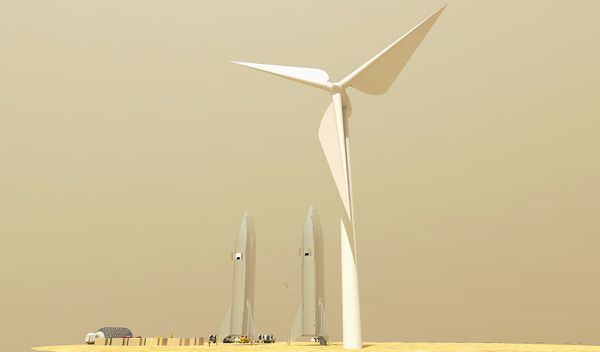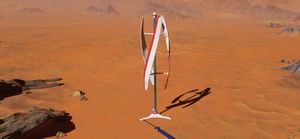Wind turbine
Wind turbines can generate electric or pneumatic energy. This would be particularly useful in situations where other methods of power generation are inappropriate, such as during dust storms which can obscure the sun for weeks at a time, thereby rendering solar panels highly ineffective.[1] Missions to the poles of Mars in particular stand to benefit from wind power: polar latitudes may spend half a year with little to no sunlight, and radioisotope thermoelectric generators such as that found on the Curiosity rover give off heat which may be similarly undesirable for the scientific goals of a polar mission.[2]
Contents
How will wind power work in Mars' thin atmosphere?
Observations of dust devils and dust storms demonstrate that wind exists in the atmosphere of Mars. Yet, this atmosphere is comparatively thin, with a surface pressure less than 1% of that found on Earth.[3] This means that electricity generation via turbines would require wind speeds roughly triple those on Earth[1] or rotor blades 100-times larger[citation needed] (which in turn would pose problems for stability and material consumption). Initial evidence from the Viking and Pathfinder missions did not indicate strong winds,[1] making the viability of turbines unclear—with the fragmentary nature of the available knowledge about strength and duration of wind as well as about global wind patterns,[citation needed|Have we discovered more information since the first draft of this article?] an experimental setup and additional explorations on Mars are needed to evaluate their efficiency.
Even so, the data from the Viking and Pathfinder missions did not include findings from dust storms, which computer modeling and wind tunnel tests have shown can only be created and sustained by high levels of winds.[1] This leads to the possibility of wind turbines which exclusively operate during dust storms,[1] supplementing solar power during the very storms which impede their efficiency. NASA AMES tested a 100 kW wind turbine at their Antarctica station; while this site serves as a general Mars analog due to its harsh conditions, the thin atmosphere was obviously not recreated, and the turbine itself was far too large and heavy for current science missions.[4] A more recent study argued for the feasibility of electricity generation via wind power even outside of dust storm conditions: researchers tested a sample turbine constructed out of parchment paper, straws, wood, and LEGOs in a wind tunnel simulating typical atmospheric conditions on Mars.[5] The experiment utilized a variety of wind speeds based on those found at the Phoenix polar landing site (roughly 2-6 meters/second), finding that more efficiently-constructed turbines could theoretically power a lander equal or smaller in size to the Mars Pathfinder.
NASA proposes the following wind speeds: Wind speeds: 2-7 m/s (summer), 5-10 m/s (fall), 17-30 m/s (dust storm) (Viking Lander sites)[6]
If wind turbines are confirmed to be of value, most, if not all, of the components could be fabricated using Martian resources.[citation needed]
Issues arising from dust
Windblown dust could clog up moving parts. Also, maintenance could be expensive, as abrasion cannot be completely avoided. Lubricant may be difficult to produce on Mars and might act differently due to environmental conditions; hence, a nonlubricant-based construction such as pure magnetic bearings without direct contact may be required.
However, dust tight seals are nothing new, and vehicles operate on Earth is extremely abrasive environments, such as alumina smelters and cement plants. Specialty lubricants, such as Castrol Brayco 815Z perfluorinated polyethers have been developed for use in space and on Mars.[7]
Example calculation

P = ½*n*p*As*v3 , where n is turbine efficiency, p is atmospheric density (kg/m3), As is swept area of the turbine (m2), and v is wind speed (m/s). The maximum efficiency is 16/27 (60%) as given by Betz’ law. For a small 10m diameter turbine As=78m2, an efficiency of 31% , air density of 0,02 kg/m3 and a wind speed of 10 m/s, P= 487W. A larger, 40m blade turbine might achieve between 150 and 300 kW of power.
For the above parameters a typical large wind turbine on Earth produces 12W/kg, where the mass includes blades, generator and tower. This is less than the 33 W/kg that can be reached by solar on Mars, but the availability may be higher. In particular, during dust storms on Mars the available solar power is very low but the average air speed is higher. As the power is to the cube of the air speed, the average wind power per kg would then be about equal to the sun power per kg, making the two forms of energy complementary. So a martian settlement might want to have a mix of solar and wind to increase its diversity of power sources.
For the same size of turbine, as the air on Earth is 50 times more dense, the same turbine will produce 50 times more power. However, the martian wind turbine could be built much lighter as it handles much less power, and possible have similar overall efficiencies and power/mass ratios. A 2012 study[8] found that the cord length for a martian wind turbine would be three times longer than on Earth for a 1.5 chord ratio, and that the power and strain on the tower would be one tenth of an equivalently sized tower on Earth.
Airborne wind turbines have been studied[9] with similar parametric changes from Earth to Mars. The same reliability challenges apply to martian airborne turbines.
Emergency use
One of the prime cases for wind turbine use on Mars is to use them during storms, when solar does not function. However, this case must be compared to the possibility of adding more solar and using the excess capacity to produce methane, than can be burned in a conventional gen-set to generate emergency power during a storm. A 150 kW gen-set burns about one tonne per day of methane. As all the modern Mars settlement plans include in-situ fuel production, the back-up methane is just part of the normal production process. A 150 KW gen-set might mass about 2 tonnes, while a 150 kW wind turbine array would mass at least 20 tonnes, and likely more.
References
- ↑ 1.0 1.1 1.2 1.3 1.4 Bluck, J. (2001, October 10). NASA - News Release. Retrieved July 12, 2019, from https://www.nasa.gov/centers/ames/news/releases/2001/01_72AR.html
- ↑ Holstein-Rathlou, C., Thomas, P. E., Merrison, J., & Iversen, J. J. (2018). Wind Turbine Power Production Under Current Martian Atmospheric Conditions. LPI Contributions, 2086.
- ↑ Haberle, R. M. (1 January 2015), North, Gerald R.; Pyle, John; Zhang, Fuqing (eds.), "SOLAR SYSTEM/SUN, ATMOSPHERES, EVOLUTION OF ATMOSPHERES | Planetary Atmospheres: Mars", Encyclopedia of Atmospheric Sciences (Second Edition), Academic Press, pp. 168–177, doi:10.1016/b978-0-12-382225-3.00312-1, ISBN 9780123822253, retrieved 6 June 2019
- ↑ Coleman (ed.) (2013) NASA Spinoff, pp.106-107; cited in Holstein-Rathlou et al. (2018).
- ↑ Holstein-Rathlou, C., Thomas, P. E., Merrison, J., & Iversen, J. J. (2018). Wind Turbine Power Production Under Current Martian Atmospheric Conditions. LPI Contributions, 2086.
- ↑ https://nssdc.gsfc.nasa.gov/planetary/factsheet/marsfact.html
- ↑ Castrol space lubricants https://www.castrol.com/en_gb/united-kingdom/home/industrial/lubricants-by-sector/aerospace/applications/space.html
- ↑ https://pdfs.semanticscholar.org/2691/3339453d63ac462d90152bdf68e7a67c02ff.pdf
- ↑ https://newatlas.com/nasa-airborne-wind-power/23200/







